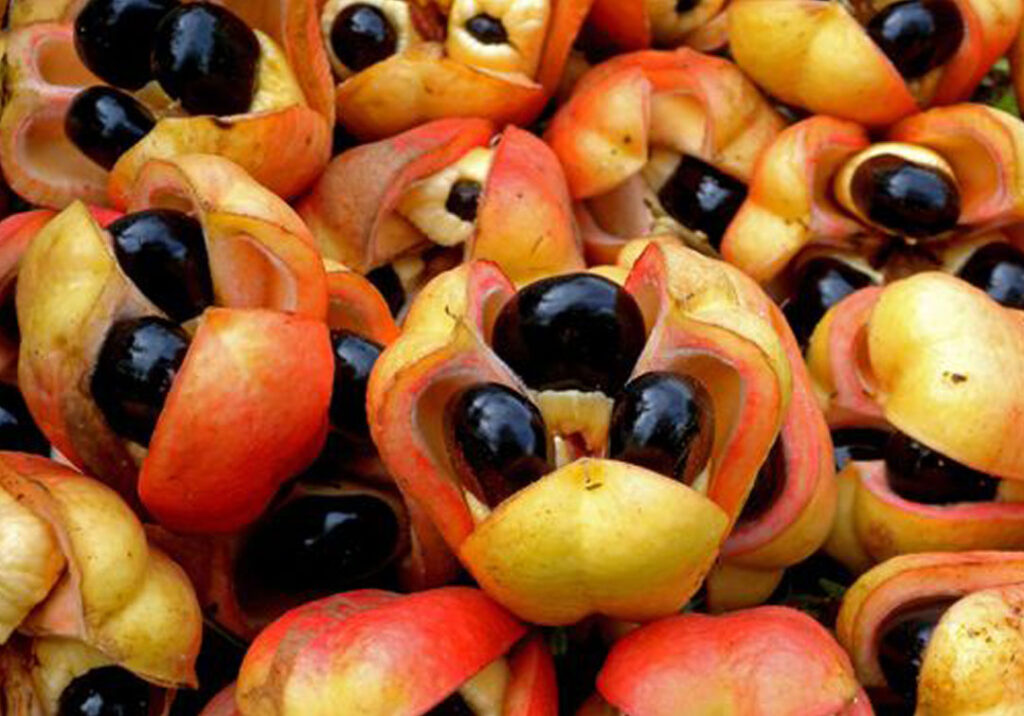The popular Jamaican folk song ‘Linstead Market,’ the words “Carry me ackee go a Linstead
Market, not a quattie wud sell” resound, paying homage to the cherished ackee fruit. This fruit,
scientifically known as Blighia Sapida, not only holds the esteemed title of Jamaica’s national
fruit but also plays a starring role in the nation’s signature dish – ackee and saltfish (codfish).
What’s intriguing, though, is that ackee is often referred to as a “poisonous” fruit. How can a
potentially dangerous fruit find its way into the hearts and kitchens of Jamaicans? Let’s explore
the captivating history and culinary journey of ackee.
The Ackee Tree: West African Roots Inna Jamaica
The ackee tree (Blighia sapida) boasts roots that stretch across continents and centuries,
offering a captivating narrative that spans cultures and trade routes. Native to the lush
landscapes of West Africa, this remarkable tree embarked on a transatlantic voyage during the
era of the notorious slave trade. The etymology of ‘ackee’ leads us to the vibrant linguistic
tapestry of Ghana, where it was originally known as ‘Ankye’ in the Twi language. This linguistic
link serves as a testament to the far-reaching influence of this fruit, transcending borders and
oceans.
Captain Bligh, famed for his involvement in the infamous “Mutiny on the Bounty,” played an
unexpected role in ackee’s history. In 1793, he undertook a voyage that would transport not only
ackee plants but also the first breadfruit specimens from Jamaica to England.The botanical
name of the fruit – Blighia Sapida – was given in honour of Captain William Bligh
Introduction to Jamaica:
Before Captain Bligh’s intervention, ackee remained unknown to science. Dr. Thomas Clarke, a
pioneer in propagating the tree, introduced it to the eastern parishes of Jamaica in 1778. From
there, the ackee tree flourished, growing up to an impressive 15.24 meters (50 feet) under
favorable conditions. The ackee tree bears striking red and yellow fruit, measuring between 7.5
to 10 centimeters (3-4 inches) in length. Upon ripening, these fruits spontaneously burst open,
revealing shiny black round seeds atop a partially edible yellow aril.
Two Varieties of Ackee:
Ackee comes in two primary varieties, distinguished by the color of their aril. ‘Butter’ ackee boasts a soft yellow aril, while ‘cheese’ ackee features a hard, cream-colored aril. The belief in ackee’s toxicity is not a myth; it’s grounded in scientific fact. Unripe ackee contains hypoglycin, a potent toxin. Ingesting it prematurely can lead to “Jamaican Vomiting Sickness,” characterized by severe nausea, vomiting, and, in severe cases, hypoglycemic coma or fatality.
To enjoy ackee safely, follow these steps:
Wait until the pods naturally open before harvesting the fruit. Thoroughly clean the aril to remove any red fibers.
Discard the cooking water when preparing ackee dishes. Or it is best to have a Jamaican show you how to pick and cook it. Jamaicans normally have mastered the art of safely consuming ackee.
Ackee and Saltfish: A Culinary Marvel:
The pinnacle of ackee’s transformation is evident in “Ackee and Saltfish.” This beloved dish
melds the creamy, subtly nutty ackee arils with savory salted codfish, sautéed onions, tomatoes,
and an array of spices. It’s a culinary masterpiece that underscores Jamaican ingenuity and the
resilience of its culinary traditions.
Beyond the Plate:
Beyond its culinary importance, ackee has also made its mark on Jamaican culture. The ackee
fruit is featured on Jamaica’s national coat of arms, symbolizing the country’s natural wealth. It’s
a source of pride and connection for Jamaicans worldwide, evoking memories of home and
family.
Cultural Significance:
“Ackee and Saltfish” transcends its role as a meal; it embodies Jamaican heritage and unity. It
signifies the fusion of African, indigenous, and European culinary traditions. The dish
encapsulates the vibrant tapestry of Jamaican culture.
Conclusion:
Ackee’s journey from a potentially perilous introduction to becoming Jamaica’s cherished
national dish is a testament to the island’s cultural richness and tenacity. Acknowledging the
inherent danger of unripe ackee, Jamaicans have perfected the art of ripening, ensuring that
this iconic dish is both delectable and safe. When you savor “Ackee and Saltfish,” you partake
in a centuries-old tradition, symbolizing the strength and ingenuity of the Jamaican people.


